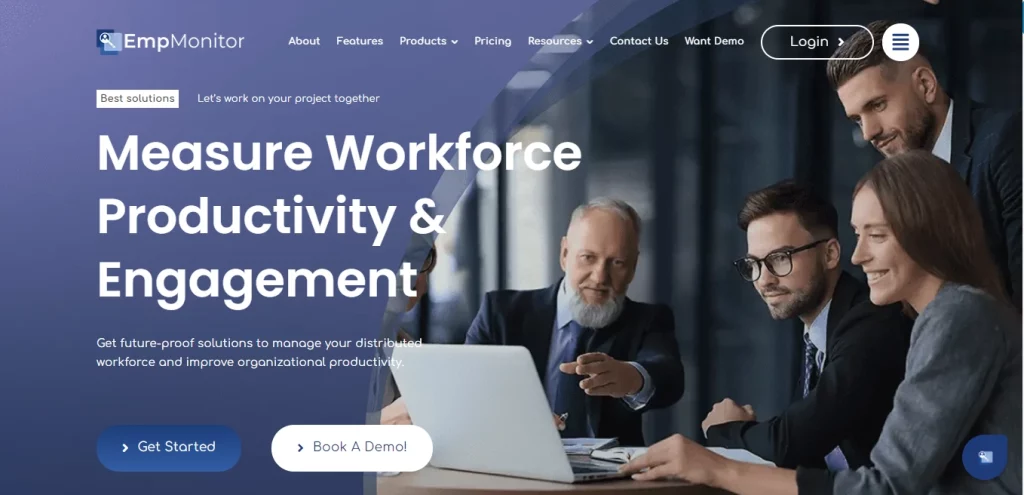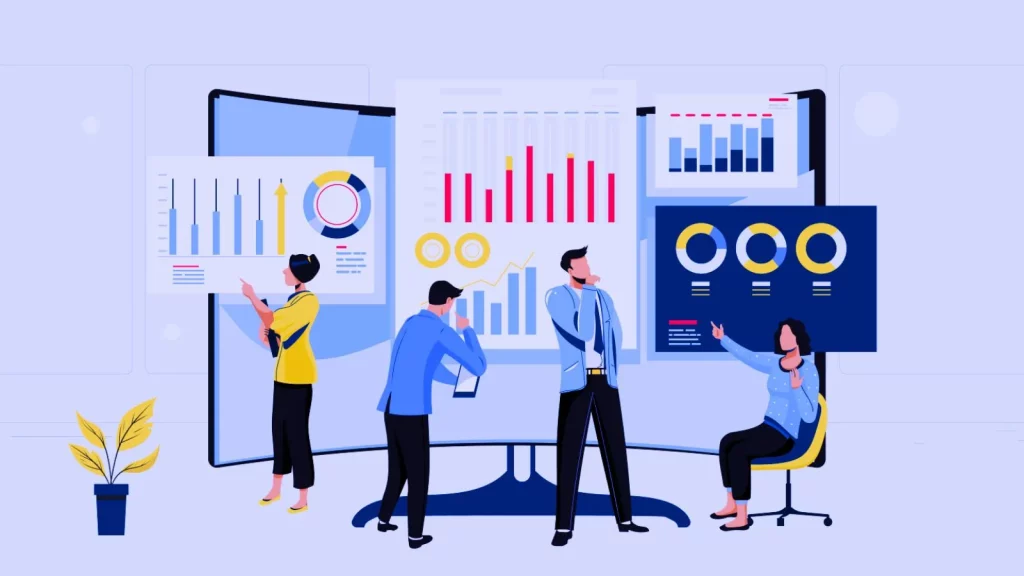High employee turnover rates pose significant challenges for companies, leading to high recruitment costs and operational disruptions. In such a case, people analytics can be a game-changer in overcoming these issues by providing strategic insights into workforce planning.
By analyzing employee behavior data, organizations can discover the root causes of turnover, such as lack of engagement or inadequate compensation. Based on such information, HR can implement targeted interventions to improve retention, such as personalized development programs and competitive benefits packages.
Furthermore, people analytics facilitates proactive workforce planning by predicting future talent needs and identifying potential skill gaps. This enables HR to build a robust talent pipeline, ensuring the company is well-prepared to fill critical roles swiftly and efficiently.
Integrating people analytics into their strategic framework could help companies enhance their ability to retain top talent and streamline recruitment processes, ultimately securing a sustainable competitive advantage.
Let’s understand:
Listen To The Blog Post!
What Is People Analytics?
People analytics is a data-driven approach that focuses on studying employees’ work processes to understand their capabilities. This method enables HR management to gain valuable insights into top talents and skilled individuals who can work more efficiently.
This method allows companies to identify and nurture high performers, optimizing their workforce for maximum productivity. Consequently, people analytics is often synonymous with HR analytics, reflecting its critical role in strategic human resource management.
Basically, there are three components of people analytics that you must know- they are data, analytics, and insights.
Collect People Data
Collecting people data involves systematically gathering information on employees’ work patterns and characteristics- within the organization. This data encompasses demographic details such as age, gender, and geographic location. Additionally, it includes key performance indicators such as work engagement hours, job performance metrics, and role-specific information.
For instance, in a sales team, you might track the number of closed deals or sales quotas met by each employee. In a customer support team, relevant data could include the number of resolved support tickets. Salary information, job roles, and tenure also provide valuable insights. By collecting this comprehensive data, you can identify trends, measure performance, and make informed decisions to enhance overall organizational efficiency and employee satisfaction.
Effective data collection is foundational to people analytics. It ensures that the subsequent analysis and insights are right and based on relevant information. Utilizing various data sources, including employee surveys, performance management systems, and HR records, helps create a holistic view of the workforce. This thorough data collection process is essential for deriving meaningful and actionable insights that can drive strategic human resource initiatives.
Analyze The Data
After collecting the data, the next crucial step is to analyze it. It involves processing, cleaning, and organizing the data to prepare it for advanced analysis. Techniques such as complex equations, algorithms, machine learning, and other analytical methods are applied to transform raw data into comprehensible insights.
A critical component of this process is building an analytic data model. This model establishes relationships between various data points, enabling more nuanced and valuable insights. For instance, by connecting data on employee performance, engagement, and demographics, organizations can gain a deeper understanding of workforce dynamics.
The ability to analyze data effectively allows leaders to address complex, multidimensional questions. For example, they can determine how to optimize production operations to meet staffing needs or assess the impact of factors like resignations and wage inflation on operating costs. This level of analysis turns disparate data into actionable insights that can drive strategic decisions and improve overall business performance.
It would help the organizations to uncover patterns and trends that might otherwise remain hidden. This process not only enhances decision-making but also helps in proactively addressing workforce challenges, ultimately leading to a more efficient and resilient organization.
Get Insight From Analyzed Data
Analyzing collected data transforms raw figures into meaningful insights about your employees. Instead of sifting through unprocessed data, analysis helps you visualize trends and patterns through graphs, charts, and dashboards. This visualization facilitates easier comparison and interpretation, enabling you to identify key areas of interest or concern.
These insights are crucial for informed decision-making in strategic workforce planning. By understanding performance metrics, engagement levels, and demographic trends, you can make data-driven decisions to enhance productivity and employee satisfaction.
Using people analytics tools like EmpMonitor, you can gather employees’ work data and analyze them to get insights. It empowers managers and HR professionals to independently explore and derive insights, speeding up the decision-making process and improving overall organizational efficiency.
How To Use EmpMonitor For Analyze People?
EmpMonitor is a powerful people analytics software with features that allow management to analyze their workforce. And accordingly, they can even utilize it to manage their strategic workforce planning and analytics. Here’s how you can utilize its features to analyze people’s data:
Comprehensive Data Collection
EmpMonitor offers extensive data collection capabilities, capturing detailed information about employees’ activities. It includes tracking work hours, application usage, websites visited, and keystrokes.
Management can use this data to understand employees’ productivity patterns, identify peak performance periods, and detect potential time-wasting activities. Using this granular data, organizations can make informed decisions to optimize workforce productivity.
Real-Time Monitoring and Alerts
One of EmpMonitor’s standout features is its real-time monitoring and alert system. HR managers can monitor employee activities in real-time, which helps maintain transparency and accountability.
Instant alerts for suspicious activities or policy violations enable prompt corrective actions. It ensures that management can address issues immediately, preventing potential problems from escalating. Real-time monitoring also aids in understanding immediate productivity levels and making necessary adjustments on the fly.
Detailed Reports and Analytics
This workforce analytics software generates detailed reports and analytics, offering insights into various aspects of employee performance. HR and management can access comprehensive reports on individual and team performance, including metrics such as active hours, idle time, and application usage.
These reports are customizable, allowing organizations to focus on specific data points relevant to their needs. The analytical insights derived from these reports help in identifying top performers, understanding training needs, and making strategic workforce planning decisions.
Employee Attendance and Time Tracking
EmpMonitor’s attendance and time tracking feature provides an accurate record of employee work hours, including login and logout times. This feature helps HR maintain precise attendance records, calculate payroll accurately, and ensure compliance with labor regulations.
By analyzing attendance data, management can identify patterns of absenteeism or tardiness and address these issues proactively. It ensures better workforce management and helps the management maintain high levels of employee discipline.
Productivity Analysis
EmpMonitor allows HR and management to conduct thorough productivity analysis by examining the data collected on employees’ work activities. Analyzing the time spent on various tasks and applications could help organizations identify productivity bottlenecks and areas that need improvement.
This analysis can also reveal employee behavior trends, helping management implement targeted interventions to boost productivity. Additionally, productivity analysis assists in aligning workforce efforts with organizational goals, ensuring that employees work efficiently towards common objectives.
Enhanced Security and Data Protection
With EmpMonitor, organizations can ensure the security and protection of their data. The software monitors and records all activities related to data access and transfer, helping in identifying any unauthorized actions. HR and management can use this feature to prevent data breaches and ensure compliance with data protection regulations. By analyzing security-related data, organizations can implement robust policies and procedures to safeguard sensitive information, thereby enhancing overall data security.
Remote Workforce Management
EmpMonitor is particularly useful for managing remote and hybrid workforces. The software provides insights into the productivity and activities of remote employees, ensuring they remain engaged and productive. HR and management can monitor remote workers’ performance in real time, analyze their work patterns, and ensure they have the necessary support to perform their tasks efficiently. This feature is invaluable in the current work environment, where remote work has become increasingly common, enabling organizations to maintain high productivity regardless of employees’ physical locations.
Leveraging EmpMonitor- Workforce planning software comprehensive features management can gather valuable insights into employee performance, productivity, and behavior. This data-driven approach facilitates better decision-making, enhances workforce management, and ultimately leads to improved organizational efficiency and employee satisfaction.
Read More
Workforce Planning And Analytics: Why It Is Useful?
Workforce Planning Software: Reform Your Management Plans
How Does People Analytics Can Help With Strategic Workforce Planning?
People analytics enhances strategic workforce planning by enabling data-driven decisions regarding employees’ skills and talents. This way, organizations can better match employees to roles that optimize their potential, driving business growth.
This approach ensures that workforce planning is both efficient and aligned with strategic objectives, as it identifies skill gaps, predicts future needs, and informs training and development initiatives.
Consequently, organizations can allocate resources more effectively, improve employee satisfaction, and foster a more agile and responsive workforce, ultimately contributing to long-term business success.
Identifying Workforce Gaps:
People analytics provides valuable insights into current workforce composition, highlighting existing skill gaps and areas where additional talent is needed. It enables HR management to proactively search for candidates with the required skills, ensuring that the organization is well-equipped to meet its strategic goals. Analyzing people analytics examples helps the organization create effective strategies to attract profitable skilled candidates.
By identifying these gaps early, companies can avoid disruptions and maintain productivity. Moreover, by understanding where these gaps, management can put more recruitment efforts into attracting the right talent, thus creating a more competent and well-rounded workforce that supports the company’s growth and operational needs.
Forecasting Future Work Development:
Analyzing the workforce can also help you predict future workforce trends and requirements based on historical data and predictive modeling. It allows organizations to anticipate changes in work demand and prepare accordingly by adjusting their hiring and training strategies. Forecasting future work development could help companies align their workforce planning with long-term business objectives, ensuring they have the right skills to support new initiatives and market demands. This foresight is crucial for maintaining a competitive edge, as it enables the organization to be proactive rather than reactive, thereby optimizing workforce readiness and performance.
Optimizing Workforce Efficiency:
Understanding employees’ existing skills and potential through people analytics would also help in optimizing workforce efficiency. Organizations can identify which employees are best suited for particular tasks and where there is potential for skill development.
This would help them enhance employees’ capabilities further, leading to improved performance and productivity. It not only maximizes the utilization of current talent but also builds a more adaptable and skilled workforce. In turn, this contributes to higher job satisfaction and retention rates, as employees feel valued and supported in their professional growth.
Tracking and Adjusting Workforce Planning Strategies:
People analytics enables continuous monitoring and evaluation of workforce planning strategies. By tracking key performance indicators and outcomes, organizations can assess the effectiveness of their workforce initiatives.
This ongoing analysis allows for timely adjustments to strategies, ensuring they remain aligned with business objectives and market conditions. If companies can refine these plans based on real-time data, they can improve workforce efficiency and overall ROI.
This iterative process of evaluation and adjustment helps create a dynamic and responsive workforce strategy that consistently supports organizational success and drives long-term growth.
Six Ways to Apply People Analytics in Your Business
- Enhance Recruitment Processes: Use people analytics to identify the traits and skills of top performers. Analyze historical hiring data to improve job descriptions, streamline the interview process, and predict candidate success, leading to better hiring decisions.
- Optimize Workforce Planning: Analyze employee demographics, skills, and performance data to anticipate future staffing needs. This helps in proactive succession planning, identifying skill gaps, and developing targeted training programs.
- Improve Employee Engagement: Track engagement metrics such as survey results, participation in company activities, and feedback trends. Use this data to develop initiatives that boost morale, reduce turnover, and enhance overall job satisfaction.
- Boost Productivity: Monitor work patterns and performance data to identify productivity bottlenecks. Implement strategies to address inefficiencies, allocate resources effectively, and set realistic performance targets.
- Enhance Employee Retention: Identify the factors contributing to employee turnover by analyzing exit interviews, performance reviews, and engagement surveys. Develop retention strategies, such as career development programs and improved workplace policies.
- Promote Diversity and Inclusion: Use analytics to assess diversity metrics within the organization. Identify areas for improvement, implement diversity initiatives, and monitor their impact to foster an inclusive work environment.
Conclusion
People analytics is essential for bridging the gap between employee dynamics and organizational objectives. It can effectively help in understanding critical aspects of workforce behavior and performance, enabling informed decision-making.
This, in turn, leads to increased efficiency, higher employee satisfaction, and better alignment with business goals. By leveraging the full potential of people analytics, organizations can elevate their operations and achieve new levels of success.
FAQs
How can people analytics enhance performance management?
People analytics enhances performance management by providing data-driven insights into employee performance and productivity. By analyzing performance metrics, feedback, and behavioral data, organizations can identify high performers, address underperformance, and tailor development programs to individual needs, thereby fostering a culture of continuous improvement and excellence.
How can people analytics improve the onboarding process?
People analytics can improve the onboarding process by analyzing data from new hires’ experiences and outcomes. By identifying patterns in successful onboarding practices, organizations can refine their onboarding programs to ensure new employees integrate smoothly, understand their roles quickly, and become productive faster. That leads to higher retention rates and better initial performance.
How do people analytics help in optimizing compensation and benefits?
People analytics helps optimize compensation and benefits by analyzing data on employee performance, market trends, and compensation benchmarks. It ensures that pay structures are competitive and aligned with employee contributions. Additionally, by understanding employee preferences and satisfaction with benefits, organizations can tailor their offerings to meet the needs of their workforce, enhancing overall job satisfaction and retention.















